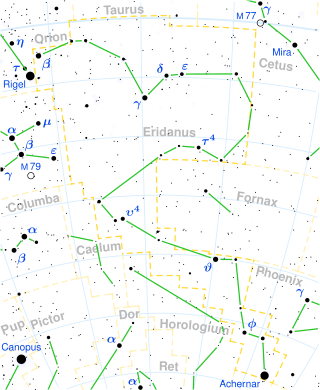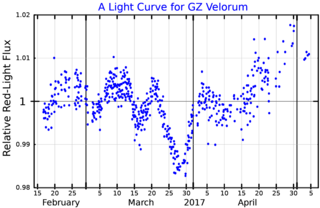Related Research Articles

θ Trianguli Australis, Latinized as Theta Trianguli Australis, is a single star in the southern constellation of Triangulum Australe. It is visible to the naked eye as a dim, yellow-hued star with an apparent visual magnitude of +5.50. The star is located about 334 light years from the Sun based on parallax, and is drifting further away with a radial velocity of +10 km/s.
65 Andromedae, abbreviated 65 And, is a single, orange-hued star in the northern constellation of Andromeda. With an apparent magnitude of 4.73, it is visible to the naked eye. The distance to 65 And can be derived from its annual parallax shift of 7.5 mas, which yields a range of around 440 light years. At that distance, its brightness is relatively lowered primarily by the inverse square law but also by an extinction of 0.16 magnitude due to interstellar dust. The star is moving closer to the Earth with a heliocentric radial velocity of −5 km/s.
10 Andromedae, abbreviated 10 And, is an astrometric binary star system in the northern constellation of Andromeda. 10 Andromedae is the Flamsteed designation. It has an apparent visual magnitude of approximately 5.81, which means it is faintly visible to the naked eye. Based upon an annual parallax shift of 6.6 mas, it is located 492 light years away. The system is moving toward the Earth with a heliocentric radial velocity of −1.1 km/s.
70 Aquilae, abbreviated 70 Aql, is a single orange-hued star in the equatorial constellation of Aquila. 70 Aquilae is its Flamsteed designation. It is visible to the naked eye with an apparent visual magnitude of 4.90. The distance to 70 Aquilae, as determined from its annual parallax shift of 3.5 mas, is around 940 light years. The star is moving closer to the Earth with a heliocentric radial velocity of −9 km/s.
66 Aquilae, abbreviated 66 Aql, is a fifth-magnitude star in the constellation of Aquila. 66 Aquilae is its Flamsteed designation. It is visible to the naked eye, having an apparent visual magnitude of 5.44. The star shows an annual parallax shift of 4.4 mas, which provides a distance estimate of around 730 light years. It is moving closer to the Earth with a heliocentric radial velocity of −30 km/s. The motion of the star over time suggests some displacement, which may indicate it is a close binary system.

Tau4 Eridani is a binary star system in the constellation Eridanus. It is visible to the naked eye with an apparent visual magnitude of 3.65. The distance to this star can be estimated using the parallax method, which yields a value of roughly 300 light years.
HD 197036 is a single star in the northern constellation Cygnus. It has an absolute magnitude of −1.15 and an apparent magnitude of 6.61, below the max naked eye visibility. Located 1,310 light years away, it is approaching Earth with a heliocentric radial velocity of −15 km/s.
HD 88809 is a star located in the southern constellation Antlia. With an apparent magnitude of 5.89 it is barely visible to the naked eye under ideal conditions. The star is located at a distance of around 451 light years but is drifting away at a heliocentric radial velocity of almost 20 km/s.
Lambda Mensae, Latinized from λ Mensae, is an orange-hued star in the southern constellation of Mensa. It has an apparent visual magnitude of 6.53, which places it at or near the limit on stars visible to the naked eye. According to the Bortle scale, it requires a dark night from rural skies for this star to be viewed. Though it has the designation Lambda, it is actually the twenty-fourth-brightest star in the constellation and not the eleventh-brightest.
HD 200661 is a solitary star in the equatorial constellation Equuleus. It has an apparent magnitude of 6.41, placing it near the max naked eye visibility. The star is situated at a distance of 430 light years but is approaching with a heliocentric radial velocity of −12.1 km/s.
HD 10550 is a single star in the equatorial constellation of Cetus. It is a faint star but visible to the naked eye with an apparent visual magnitude of 4.98. Based upon an annual parallax shift of 2.9564 mas, it is located around 1,100 light years from the Sun. The star is moving closer with a heliocentric radial velocity of −33 km/s. It has a high peculiar velocity of 72.7+5.7
−4.3 km/s and may be a runaway star.
Iota Eridani is a solitary star in the constellation Eridanus. It is visible to the naked eye with an apparent magnitude of 4.11. With an annual parallax shift of 0.02165 arcseconds, it lies at an estimated distance of about 151 light years.
Kappa Eridani, Latinized from κ Eridani, is a solitary star in the constellation Eridanus. With an apparent visual magnitude of 4.25, it is bright enough to be visible to the naked eye on a dark night. Based upon an annual parallax shift of 0.00642 arc seconds, it is roughly 510 light years distant from the Sun.
HD 74772 is a single star in the southern constellation of Vela. It is positioned near the Vela SNR, which gives it an intense X-ray background. The star is of apparent visual magnitude 4.05, and hence is visible to the naked eye. Based upon an annual parallax shift of 15.8 mas, it is located 207 light years from the Sun. It is moving closer to the Earth with a heliocentric radial velocity of −2 km/s.

GZ Velorum is a single, orange-hued star in the southern constellation of Vela. It is a faint star but visible to the naked eye, having an apparent visual magnitude of 4.58. The star is located around 1,300 light years from Earth, as determined from its annual parallax shift of 2.4 mas. It is moving further away with a heliocentric radial velocity of +13 km/s.
HD 89998 is a single star in the southern constellation of Vela. It is a faint star but visible to the naked eye with an apparent visual magnitude of 4.82. The distance to HD 89998, as determined from its annual parallax shift of 15.9 mas, is 205 light years. The star is moving further from the Earth with a heliocentric radial velocity of +21 km/s, having come within 140 ly some 1.552 million years ago.
HD 32453 is a solitary star located in the southern constellation Caelum. With an apparent magnitude of 6.01, it's barely visible to the naked eye under ideal conditions. This star is located 407 light years away based on its parallax shift, but is drifting away at a rate of 5.73 km/s.
Iota Octantis, Latinized, from ι Octantis is a double star in the southern circumpolar constellation Octans. The "A" component has an apparent magnitude of 5.83, making it faintly visible to the naked eye under ideal conditions, but the "B" component can't be seen due to its faintness. The system is located at a distance of 350 light years based on its annual parallax shift, but is drifting away at a rate of 53.4 km/s.
HD 30479 is a solitary star in the southern circumpolar constellation Mensa. It has an apparent magnitude of 6.04, making it barely visible to the naked eye even under ideal conditions. It is located at a distance of 540 light years but is receding with a heliocentric radial velocity of 10.3 km/s.
HD 196775 is a solitary star in the equatorial constellation Delphinus. It has an apparent magnitude of 5.98, allowing it to be faintly seen with the naked eye. The object is relatively far at a distance of 1,050 light years but is approaching the Solar System with a heliocentric radial velocity of −4.6 km/s. HD 196775 has a high peculiar velocity of 21.8+1.9
−4.1 km/s compared to neighboring stars, indicating that it may be a runaway star.
References
- 1 2 3 Brown, A. G. A.; et al. (Gaia collaboration) (August 2018). "Gaia Data Release 2: Summary of the contents and survey properties". Astronomy & Astrophysics . 616. A1. arXiv: 1804.09365 . Bibcode: 2018A&A...616A...1G . doi: 10.1051/0004-6361/201833051 . Gaia DR2 record for this source at VizieR.
- ↑ Høg, E.; Fabricius, C.; Makarov, V. V.; Urban, S.; Corbin, T.; Wycoff, G.; Bastian, U.; Schwekendiek, P.; Wicenec, A. (March 2000). "The Tycho-2 catalogue of the 2.5 million brightest stars". Astronomy and Astrophysics. 355: L27–L30. Bibcode:2000A&A...355L..27H. ISSN 0004-6361.
- 1 2 Houk, Nancy (1978). Michigan catalogue of two-dimensional spectral types for the HD stars Volume II: Declinations −53° to −40°. Bibcode:1978mcts.book.....H.
- ↑ Johnson, H. L.; Mitchell, R. I.; Iriarte, B.; Wisniewski, W. Z. (1966). "UBVRIJKL Photometry of the Bright Stars". Communications of the Lunar and Planetary Laboratory. 4: 99–110. Bibcode:1966CoLPL...4...99J.
- ↑ Gontcharov, G. A. (November 2006). "Pulkovo Compilation of Radial Velocities for 35,495 Hipparcos stars in a common system". Astronomy Letters. 32 (11): 759–771. arXiv: 1606.08053 . Bibcode:2006AstL...32..759G. doi:10.1134/S1063773706110065. eISSN 1562-6873. ISSN 1063-7737. S2CID 119231169.
- 1 2 van Leeuwen, Floor (13 August 2007). "Validation of the new Hipparcos reduction". Astronomy & Astrophysics. 474 (2): 653–664. arXiv: 0708.1752 . Bibcode:2007A&A...474..653V. doi: 10.1051/0004-6361:20078357 . eISSN 1432-0746. ISSN 0004-6361. Hipparcos record for this source at VizieR.
- 1 2 3 Anderson, E.; Francis, Ch. (1 May 2012). "XHIP: An extended hipparcos compilation". Astronomy Letters. 38 (5): 331–346. arXiv: 1108.4971 . Bibcode:2012AstL...38..331A. doi:10.1134/S1063773712050015. ISSN 1063-7737. S2CID 119257644.
- 1 2 3 4 5 Anders, F.; et al. (1 August 2019). "Photo-astrometric distances, extinctions, and astrophysical parameters for Gaia DR2 stars brighter than G = 18" (PDF). Astronomy and Astrophysics. 628: A94. arXiv: 1904.11302 . Bibcode:2019A&A...628A..94A. doi:10.1051/0004-6361/201935765. ISSN 0004-6361. S2CID 131780028.
- 1 2 Lang, Kenneth R. (2006), Astrophysical formulae, Astronomy and astrophysics library, vol. 1 (3 ed.), Birkhäuser, ISBN 3-540-29692-1 . The radius (R*) is given by:
- 1 2 3 Stevens, Daniel J.; Stassun, Keivan G.; Gaudi, B. Scott (1 December 2017). "Empirical Bolometric Fluxes and Angular Diameters of 1.6 Million Tycho-2 Stars and Radii of 350,000 Stars with Gaia DR1 Parallaxes". The Astronomical Journal. 154 (6): 259. arXiv: 1708.05025 . Bibcode:2017AJ....154..259S. doi:10.3847/1538-3881/aa957b. ISSN 0004-6256. S2CID 119191064.
- 1 2 De Medeiros, J. R.; Alves, S.; Udry, S.; Andersen, J.; Nordström, B.; Mayor, M. (1 January 2014). "A catalog of rotational and radial velocities for evolved stars. V. Southern stars". Astronomy and Astrophysics. 561: A126. arXiv: 1312.3474 . Bibcode:2014A&A...561A.126D. doi:10.1051/0004-6361/201220762. ISSN 0004-6361. S2CID 54046583.
- ↑ "HR 6778". SIMBAD . Centre de données astronomiques de Strasbourg . Retrieved 15 September 2021.
- ↑ Mason, Brian D.; Wycoff, Gary L.; Hartkopf, William I.; Douglass, Geoffrey G.; Worley, Charles E. (1 December 2001). "The 2001 US Naval Observatory Double Star CD-ROM. I. The Washington Double Star Catalog". The Astronomical Journal. 122 (6): 3466–3471. Bibcode:2001AJ....122.3466M. doi: 10.1086/323920 . ISSN 0004-6256.
